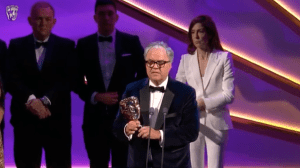I don’t know what most people do to wind down after Hump Day, but my guess is it doesn’t typically involve late-term abortion. For a group of activists and journalists who gathered in the basement of the Capitol Building, however, that’s just what the last Wednesday night of October was about. Two tables of smiling NARAL staff greeted attendees who chatted and laughed among themselves as they picked up individual serving-size containers of movie theater popcorn and miniature candy bars before settling into their seats for “After Tiller,” a documentary on everybody’s favorite topic of conversation: how women decide to end pregnancies that have reached the third trimester.
The documentary tells the stories of the only four doctors in the United States who legally perform third-trimester abortions, weaving their narratives with the stories of the women who come to them for the procedure. It also treats the way the doctors’ work affects the lives of their families, friends, and even animals. And it highlights, without flinching, the messy paradoxes that pro-choice — and, commensurately, pro-life — activists have to grapple with. It’s not pleasant, but it’s very, very gripping.
First, though, a quick little aside: You might remember the predictable furor of sorts that erupted about a year and a half ago when comedian Sarah Silverman tweeted a joke, complete with before and after pictures, about getting a “quickie aborsh” in case Roe v. Wade was overturned (her round belly in the “before” picture, she later explained, was only enlarged because of some Mexican food). Besides the fact that there were still people who are shocked when Sarah Silverman flirts with the boundaries of good taste, the main lesson from that interesting chapter in the History of American Women Joking About Abortion is that, well, it’s very doable. The feminist site Jezebel, in fact, lauded her stunt. “She may have only aborted a burrito,” write one of the site’s contributors, “that only intensifies my love for this woman.” Burrito abortions, OMG ROFL!
Anyway, “After Tiller” is a jarring antidote to that. It’s wholly serious — grave, even — and has no room for the snarky tone you often find in online commentary on the abortion issue. In a way, the film functions as an apology for George Tiller’s mantra and legacy. Tiller, the late-term abortion doctor who was assassinated in 2009 at his church in Wichita, often wore a button that said “Trust Women.” The four practitioners profiled in “After Tiller” had all been part of his practice, and concurred that his murder made them more committed to continuing his work, not less.
But that doesn’t mean the work is easy, and it’s the first big question the film asks: What exactly does it mean for a woman to get an abortion? Shelley Sella, one of the doctors, had a background in midwifery before she entered the abortion field. In fact, she first met Tiller after she heard him give a speech where he said, “The woman’s body is smarter than the doctor.” Sella tells the filmmakers that she approached him after the talk, mentioned his comment, and said, “That’s midwifery!” Within a few minutes, she’d decided to learn the procedure. But she explains that her work isn’t easy.
“I think the reason I’ve struggled is that I think of them as babies,” she says. “I don’t think of that as a fetus.”
“That’s not a tissue; it’s a baby,” she continues. “It’s inside the mother, and she can’t handle it for many, many extremely desperate reasons.”
‘It’s not a fetus, it’s a baby’ is something you’d expect to see on a placard being waved outside a Planned Parenthood, and Sella’s explanation of the struggle in her work is one of the most surprising moments in the film — it’s practically reason enough to see it.
And that set of circumstances — a baby in a mother who can’t handle it — raises the second jarring question of the film, though it’s an unstated one: To what extent do these doctors really trust women? And when women get abortions, are they always making the right choice? The doctors have a finite amount of slots for patients, and sometimes they have to reject women trying to get late-term abortions; in other words, they have to perform triage and, thus, make judgments about who needs an abortion most and who needs one least. In one scene, a clinic receptionist explains to a French woman trying to fly out to Albuquerque for the procedure (she doesn’t have a compelling health need for the abortion) that they won’t be able to fit her in and that she might need to look into adoption. In another scene, one of the doctors discusses with a staffer at the clinic whether or not to perform an abortion on a 16-year-old girl whose physical health isn’t jeopardized by the pregnancy and whose boyfriend’s parents have offered to adopt the child. The staffer doesn’t think the doctor, Susan Robinson, should go through with the abortion. But after speaking with the pregnant girl, the doctor decides to do it.
She defends performing late-term abortions on women who make weak cases for getting the procedure by arguing that a woman shouldn’t be denied an abortion just because she isn’t a very good storyteller. “‘No, that’s not a good enough story, I’m not going to do an abortion for you,’” she says, paraphrasing a pronouncement she won’t make to her patients.
“Where does it come from that I get to say, ‘Oh yeah, well, why?’” Robinson says, adding later, “They are the world’s expert on their own lives.”
Her staffer doesn’t seem to agree. And the filmmakers don’t really cast judgment on the situation — there’s no deus ex machina to tell you how to feel about a 16-year-old aborting a healthy baby that has a waiting would-be adoptive family.
That said, most of the cases don’t seem quite as morally excruciating to the abortion providers. (N.b.: The fact that the filmmakers actually portray a number of women talking through their decisions to get abortions before or after receiving the procedure struck me as really exceptional. It’s the opposite of “Teen Mom”; none of the patients’ faces are shown, and no one’s getting a porn gig out of it. It’s just raw footage of women trying to figure out what to do with a baby that’s been in them for 26 or so weeks.) One set of parents even asks to hold the fetus after the procedure — they’d wanted to get pregnant, but learned late in the pregnancy that their child wasn’t viable outside the womb. In one case, “Baby Boy = Hudson” is written in the margin of an appointment book. It’s heartbreaking.
All these decisions are presented in contrast to pro-life protests being held outside the clinics. You certainly get the sense that pro-life picketers are in anguish, but it’s a completely different species of the feeling. You get the sense that no matter how much the protesters feel, it doesn’t begin to compare to the pain some of the women in these clinics face. So that’s the crux of the film: It’s about how a woman and a doctor make incredibly difficult choices, and then about how they proceed to live with them.



